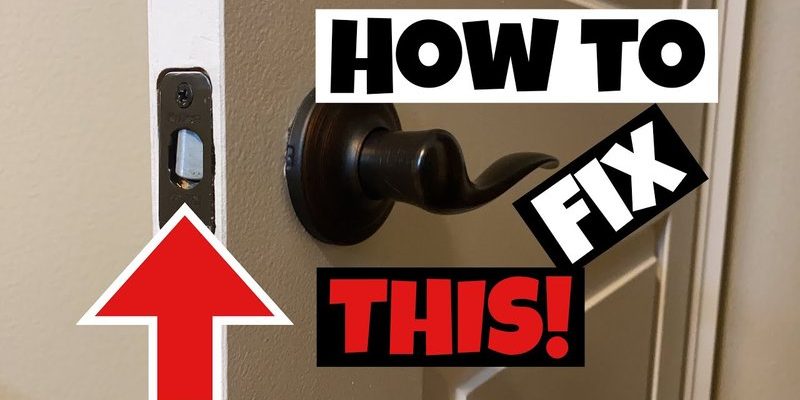
This issue can occur with various types of door latches, including those on traditional door locks or even modern smart locks. You might find that it’s something simple, like a little dirt buildup, or it could be a sign of a bigger issue. But don’t worry! By the end of this article, you’ll understand why your door latch is acting up and what you can do about it.
Understanding How a Door Latch Works
Before we dive into troubleshooting, let’s take a moment to understand how a door latch works. Think of a door latch as a tiny but essential mechanism that keeps your door securely closed. When you turn the knob or push the lever, it retracts the latch, allowing you to open the door. When you close the door, the latch extends back into the strike plate, keeping the door closed.
Most latches consist of metal parts that can be influenced by several factors. If any of these parts get stuck or misaligned, you might notice that your door latch isn’t receding smoothly. Knowing how these parts work together helps you identify what might be going wrong.
Common Reasons for a Sticky Door Latch
There are several reasons why you might find your door latch not receding smoothly. Here are some common culprits:
- Debris Buildup: Dust, dirt, or even small insects can make their way into the latch mechanism, causing it to stick.
- Rust or Corrosion: If your latch is metal, exposure to moisture can lead to rust, making it difficult for the latch to move freely.
- Misalignment: Sometimes, the door or the latch itself gets misaligned. This can occur from door settling or hinges wearing out over time.
- Worn-Out Springs: The springs within the latch can wear out, affecting their ability to retract smoothly.
Recognizing these issues can help you pinpoint the problem and take action.
How to Troubleshoot a Stuck Door Latch
If your door latch isn’t performing as it should, don’t panic! Here’s a step-by-step guide to troubleshoot the issue:
1. Inspect the Latch and Strike Plate: Start by examining the latch and the corresponding strike plate. Is there any visible debris or damage? If you see dirt, a quick clean with a damp cloth can help.
2. Lubricate the Mechanism: Sometimes, all your latch needs is a little TLC. Apply a small amount of lubricant to the latch mechanism. Use something like WD-40 or a silicone spray. Avoid using heavy oils, as they can attract more dirt.
3. Check for Misalignment: Close your door slowly and observe how the latch interacts with the strike plate. If they don’t line up correctly, you may need to adjust the hinges or the latch itself.
4. Examine for Rust: If you notice rust, you can remove it with some sandpaper or a rust remover. Afterward, be sure to wipe the area clean and apply lubrication.
5. Test the Mechanism: After cleaning and lubricating, test the latch a few times. If it still feels sticky, it could be time to replace it.
By following these steps, you should be able to identify and resolve common latch issues.
When to Seek Professional Help
Sometimes, despite your best efforts, a stubborn latch just won’t cooperate. If you’ve tried cleaning, lubricating, and realigning, but the latch still isn’t working properly, it may be time to call in a professional.
Here’s when to consider that route:
- If the latch is broken or damaged beyond simple repair, you’ll likely need a professional to replace it.
- If the door itself is misaligned significantly, a handyman or carpenter can help adjust the door frame.
- If you feel uncomfortable doing the repairs yourself, there’s no shame in asking for help!
Remember, it’s better to have someone with experience handle it than to risk making the problem worse.
Preventing Future Latch Issues
Once you’ve fixed your door latch, you’ll want to keep it in good shape. Regular maintenance can save you from future headaches. Here are some tips:
– Routine Cleaning: Make it a habit to clean the latch and surrounding area every few months. A regular clean can prevent dirt buildup.
– Lubrication Schedule: Apply lubricant to the latch every six months. It doesn’t have to be a chore—just a quick spray during your home maintenance routine!
– Check for Alignment: Every now and then, check that your door and latch remain aligned. If you notice any changes, address them sooner rather than later.
– Monitor for Rust: If your latch is in a humid area, keep an eye out for rust. If it’s forming, consider replacing it with a rust-resistant option.
Taking these preventive measures can help ensure your door latch continues to operate smoothly.
A door latch that doesn’t recede smoothly can be a minor inconvenience or a major hassle, depending on the situation. By understanding how it works and taking simple steps to troubleshoot, you can often fix the problem yourself. Whether it’s cleaning, lubricating, or adjusting a misaligned door, most issues are manageable.
If you find yourself in a situation where the latch just won’t cooperate, don’t hesitate to seek professional help. Remember, maintaining your door latch will not only prolong its life but also give you peace of mind. After all, a well-functioning door latch is essential for both your home security and daily comfort.
